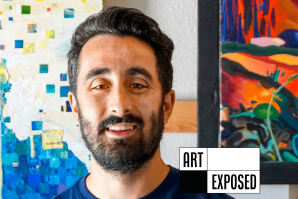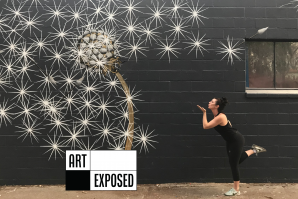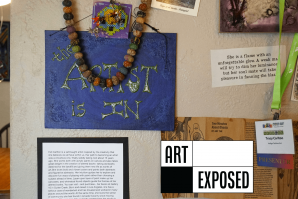“Headhunter” is composed of upcycled beads, pearls, silver
pendants and chains. The work was inspired by a dream and is
based on pre-colonial Indigenous rituals for harvest.

As a queer, first-generation Filipino American, 27-year-old Crumb remembers her Filipino roots while uplifting the community that raised her in Sacramento through her immersive artworks and thoughtful curation. Crumb’s artistic practice incorporates photography, printmaking, sculpture and ceramics and is centered on what she calls “love work,” based on the artist’s philosophy that love is not a feeling, but an action.
During her recent California Arts Council Youth Speaks Emerging Artist Fellowship, she curated “Autonymous” at E Street Gallery, a group exhibit focused on the reclamation of female power through bodily autonomy. Featuring art by nine female-identifying or nonbinary artists, works explored autonomy through gender identity, religion and other avenues of rejecting societal norms.
Supporting other artists is a thread running throughout her artistic career, from working at the University Library Gallery and curating at the R.W. & Joyce Witt Gallery at Sacramento State University to running labs as education and gallery associate at Verge Center for the Arts. Crumb is also a project coordinator at the Sacramento-based Art Tonic, which provides artists with professional development workshops and grant-writing services.
Crumb’s own art was recently exhibited in group shows at the James Kaneko Gallery at American River College, at San Francisco’s Filipino Cultural Heritage District’s Bituin Studio in San Francisco and at Oakland Photo Workshop.
Crumb’s “Prodigal Daughter” series of manipulated Polaroid film
emulsion lifts reimagines the biblical figure of Mary Magdalene
as a queer femme figure, exploring themes of cultural identity
and the Filipino American diaspora.

Food is also deeply personal for Crumb, as her late grandmother and other family members worked in food service, owning catering companies and carinderias — a kind of casual, sometimes mobile restaurant ubiquitous in the Philippines. Crumb herself has worked in the food and beverage industry and sees it as an extension of the “communal care” she grew up with.
“I think I see it too in Sacramento, because I worked in the service industry for a really long time, and there is this camaraderie that exists in food service, but particularly in Sacramento. I feel like there’s a really strong community. … I wanted to celebrate that,” Crumb says.
“Reef” includes an underwater ceramic installation and is a
commentary on human encroachment on the natural environment.

Your bio mentions that your work is guided by the ethos of “love is not a feeling, but a series of actions.” Can you elaborate on what this means to you and how it informs your artistic practice?
I think it exists through, first, a form of placemaking, which is a word that everyone loves to use right now, but truly a form of placemaking for my people. And this is my community, and I find that there aren’t a lot of spaces that are carved out for us.
So because I have the privilege of being in these spaces and exhibiting and having that platform, I really think that it’s also my job to uplift our culture and our identity from pride and love, but also I find that a lot of the work that I do professionally is in service of community. … It’s inspired by my time in (food) service because it has truly humbled me to be in that space for seven years or whatever. But also I would like the work that I do to continuously serve community in some way. Whatever shape that takes, it can’t just be for me. It should always be about other people.
I’m curious if that is something that comes from a belief that you have or is influenced by your family or cultural traditions.
Yes, because it’s kind of the pitfall of being a Filipino. I don’t want to say pitfall, but there’s this servitude, and you do it with a smile, and you do it joyfully. And Filipinos are the most happy, helpful people. And I think there’s a way to reclaim that and truly make it about building with other people, but not in a way that suppresses us. It’s like, we have that power, and we have that capacity. It is actually a joy to be able to do that.
How else do you see Filipino culture showing up in your art?
Crumb’s solo show, “Seedling,” at WAL Public Market Gallery paid
homage to family, cultural traditions and community through a
universal human need: food.

I find that my previous work had elements of me, but it wasn’t really me. And I think every artist goes through that. The early stages of your work, you might have some threads to pull on, but it’s not what you want to focus on, and maybe it’s not really aligned. So my Filipino identity shows up in the work because the work allows me to discover things about myself and my history that I might’ve forgotten or overlooked.
And this previous month in October, I was invited to a lot of Filipino-centric exhibitions, so this is a very recent process for me as far as explicitly celebrating the identity. I’m still very much learning how it’s going to continue showing up.
Your work explores themes of decolonization, cultural memory and intuitive joy. Can you share more about your interest in these themes and how they manifest in your art?
For me, it shows up through celebrating craft that is rooted in Indigeneity. … Recently I made a piece titled “Headhunter,” and that is taking inspiration from tribes that existed in the Philippines prior to colonization, where they practice headhunting as a means of expressing power. So this piece is inspired by that sort of reclaiming what it means to have power, and how do you express that?
“Promise Land” is a personal altar featuring a collaged woodcut
inspired by the artist’s homeland and an homage to her
spirituality and culture.

I learned a lot of language through other folks who are doing decolonial work and allowing that to inform my current practice, because I want everything to be, from here on out, I would like for my work to be about decolonization and decentering these systems that we’ve glorified for so long, or at least have the peace take inspiration or inspiring that kind of conversation.
You are also passionate about supporting local artists and fostering a vibrant arts community. Can you talk about your involvement with E Street Gallery and Project Coordination at Art Tonic?
So, working in arts nonprofit or other nonprofit organizations that are community-oriented, and even the work that I do now through Art Tonic, a lot of the things that we do is geared towards community. And so hosting workshops, free workshops, art process workshops, or business development workshops for artists who wouldn’t otherwise have the tools, I love doing that and being a bridge for those people. So I would say that that’s how this community, reciprocal community stems from.
“Virgie’s Garden” is an installation that includes a lenticular
photo (right) that transforms from a portrait of the artist’s
late grandmother prior to her death from COVID and as a young
woman.

We really enjoy working together. And then one of the larger projects that we did together is a series called Artistic Pathways, and for that we chose five organizations and five artists that they work with or have worked with in the past. And we hosted a free panel interview for people to attend where we asked them questions about the process, what it looked like to work with that organization.
It’s something that younger me would’ve needed for me. Now, I learned a lot during that series actually, as far as getting larger projects like that. It’s removing some of those barriers and to have it be free, that’s a big thing for me. … If an organization is inviting you to host a workshop, they should really be the ones covering the artist, but for the community, it should be accessible. So I love hosting free workshops, not that artists shouldn’t get paid. I think we should get paid for our labor and our expertise, but for the community it should be accessible.
What are your hopes for the future of art in Sacramento, and how do you see your work contributing to that future?
I think what I am most excited about, and I’m starting to see little baby projects of this happening, is collaborative efforts. I think in every industry there will be their individual silos, and the artist community in Sacramento is very siloed, I would say. But the best things that come out of the Sacramento art community are collaborative projects, like group shows, and even an example that I would use right now because they’re in my network, and I love and I support the work that they’re doing as ALMa (ALMa design Studio), and their model is sort of bringing other creatives into the space that they have the fortune of having.
I think that, and even Jazel (Jazel Muñoz, curator at WAL Public Market Gallery) has WAL and bringing other artists in, bringing them into the process of the curation and asking, ‘What do you want to see? Okay, that’s not what you want. What is it that you want?”
I think just more collaboration and communication between artists.
Edited for length and clarity.
Corrections December 11, 2024: A previous version of this story identified Crumb as a resident at Verge Center, her graduation month as May 2024, and her former workplace as the R.W. & Joyce Witt Gallery. Her title is education and gallery associate, her graduation month is December 2023 and she previously worked at the University Library Gallery and curated at the R.W. & Joyce Witt Gallery.
Stay up to date on art and culture in the Capital Region: Follow @comstocksmag on Instagram!
Recommended For You

Art Exposed: Taner Pasamehmetoglu
For this second-generation American, art is a tool to address finite resources and break down walls
“A lot of my work stems from this idea of what I call being stuck in between,” says multidisciplinary Elk Grove artist Taner Pasamehmetoglu.

Art Exposed: Maren Conrad
Meet the Sacramento muralist and designer who creates joyful spaces for women
Maren Conrad reflects on her iconic Sacramento murals and her latest project, the Jacquelyn.

Art Exposed: Doug Winter
Elk Grove photographer creates images exploring perception and memory through the lens of visual impairment
After suffering a stroke in his right eye in 2012, Elk Grove resident Doug Winter, a trained commercial photographer, began to think differently about sight and perception.

Art Exposed: Tracy ‘Indi’ Carlton
Meet the Amador County artist who traded in a 21-year nonprofit career to become a creative expression coach
Tracy Carlton took an unconventional path to her art career, launching a as a creative expression coach and teacher last year following a 21-year career at First 5 Amador, the Amador County branch of the statewide nonprofit commission dedicated to improving early childhood development.



